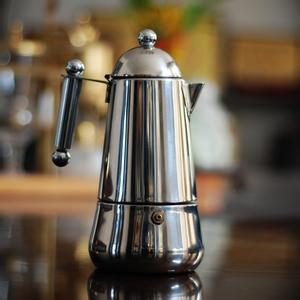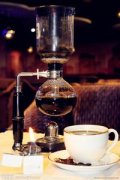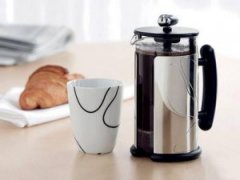Self-made coffee analysis mocha pot
The mocha pot is divided into three parts: the upper seat, the powder trough, and the lower seat. The lower seat is a sink for holding water, and the powder trough is used to hold finely ground coffee powder. The upper seat is to hold the extracted coffee liquid. When brewing, the water is placed in the lower pot and the coffee is placed in the middle of the net. when the pot is heated, it produces steam and rushes the hot water up. Pass through the coffee powder, then into the pot to form coffee. Because its air pressure is relatively high, some people classify it as high-pressure cooking. Some people call it hand-made espresso, but it can't make the foam of espresso. But it's really exciting coffee.

Steps for making coffee in a mocha pot:
Step one:
Hot water is injected into the lower seat of the mocha pot, and the water level must not exceed the lower edge of the safety valve. The safety valve is the limit of the maximum water level of each mocha kettle.
Cold water is not recommended, which will increase the time it takes to soak the coffee powder and make the extracted coffee bitter and turbid.
Step 2:
Filter paper can be pasted at the bottom of the upper seat.
This is a form of modern mocha pot making method. Ten years ago, the mocha pot was made without filter paper.
When sticking the filter paper, the filter paper should be laid correctly in the middle of the lower seat filter. In order to achieve a better fixing effect, the filter paper can be soaked with water.
Step 3:
Load the powder. This step is one of the important elements related to the cup effect of coffee (water volume, powder loading, extraction timing).
Many friends have made obvious mistakes in this step, which can be summarized as follows:
a. There is not enough powder. If you choose the highest water level in the lower seat, your powder should also be fully filled. Otherwise, with the lack of coffee powder, the taste of coffee will gradually fade.
b. Press the powder with a powder hammer. Many friends use the special powder hammer of Italian machine to press the powder trough of Mocha, which is a painstaking move. If the pressure is too tight and the coffee powder is too fine, the coffee will be difficult to draw. So the key to filling a mocha pot with real powder is to fill it as much as possible instead of pressing it tight. The powder can be injected in batches when loading the powder, and the edge of the powder trough can be covered as much as possible without leaving any gap.
When the coffee powder is full, tap the vertical table of the powder trough a few times to ensure that the coffee powder can be fully filled.
Step 4:
After placing the powder trough correctly on the lower seat, tighten the upper seat on the lower seat. You can twist it a little too much for safety.
Step 5:
Heat the properly installed mocha pot on the heat source. For ease of observation, I suggest boiling the mocha pot with the top open.
Soon the coffee liquid overflowed from the central metal column of the upper seat.
With the continuous extraction, the liquid level of coffee will rise gradually. When there is grease on the liquid surface, please be careful that the coffee extraction is coming to an end. When the color of the oil changes from dark to light, the heat source should be cut off immediately to stop the extraction, otherwise the coffee will be in a state of over-extraction.
In particular, you can't stop after the sound of "snoring". This kind of coffee may even have the taste of roasted rubber.
Step 6:
Qualified friends can prepare a towel soaked in cold water in advance and put it next to the heat source. When you finish step 5, put the mocha pot on the cold towel. This will greatly reduce the possibility of over-extraction of coffee.
Tips
The maximum service life of the sealing ring under the upper seat of the mocha kettle shall not exceed one year, pay attention to replacement. It's kind of like the rubber seal of a pressure cooker. If it is not replaced in time, there will be lax sealing and air leakage.
If the phenomenon of gas outgassing or water leakage occurs in the lower seat pressure reducing valve during the manufacture of the mocha pot, the thin metal sheet in the middle of the pressure reducing valve should be replaced in time, otherwise the pressure of the mocha pot will be greatly lost.
Important Notice :
前街咖啡 FrontStreet Coffee has moved to new addredd:
FrontStreet Coffee Address: 315,Donghua East Road,GuangZhou
Tel:020 38364473
- Prev

Homemade coffee analytical siphon pot
Siphon pot (Syphon), commonly known as "glass ball" or "siphon", is a simple and easy-to-use method of coffee brewing, and it is also one of the most popular coffee brewing methods in cafes. Although the siphon pot has the nickname of "plug wind type", it has nothing to do with the siphon principle, but uses water heating to produce water vapor, resulting in thermal expansion and cold contraction principle, push the hot water from the lower sphere to the upper pot, and then wait for the lower pot to cool.
- Next

Self-made coffee filter kettle with analytical method
The French filter kettle is not only the most convenient household coffee pot, but also the best way to retain the flavor of coffee. The French press can perfectly show the charming and mellow flavor of deep-cultured coffee. Its structure is simple, but it has many advantages. The French kettle is very suitable for lazy people. Its production principle is that it is soaked and stewed in full contact with coffee powder.
Related
- Beginners will see the "Coffee pull flower" guide!
- What is the difference between ice blog purified milk and ordinary milk coffee?
- Why is the Philippines the largest producer of crops in Liberia?
- For coffee extraction, should the fine powder be retained?
- How does extracted espresso fill pressed powder? How much strength does it take to press the powder?
- How to make jasmine cold extract coffee? Is the jasmine + latte good?
- Will this little toy really make the coffee taste better? How does Lily Drip affect coffee extraction?
- Will the action of slapping the filter cup also affect coffee extraction?
- What's the difference between powder-to-water ratio and powder-to-liquid ratio?
- What is the Ethiopian local species? What does it have to do with Heirloom native species?

